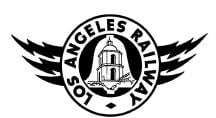Began operation 1901 Operator(s) Los Angeles Railway Track gauge 3 ft 6 in (1,067 mm) Transit type Tram | Ended operation 1963 Reporting marks LARy Number of lines 20 | |
 | ||
Locale Los Angeles, California,and its suburbs | ||
The Los Angeles Railway (also known as Yellow Cars, LARy, and later Los Angeles Transit Lines) was a system of streetcars that operated in central Los Angeles, California, and the immediate surrounding neighborhoods between 1901 and 1963. Except for two short, 2 ft 6 in (762 mm) narrow gauge funicular railways named Angels Flight and Court Flight, it operated on 3 ft 6 in (1,067 mm) narrow gauge tracks. The company carried many more passengers than the Pacific Electric Railway's 'Red Cars' which served a larger area of Los Angeles. The two companies shared some dual gauge 3 ft 6 in (1,067 mm) / 4 ft 8 1⁄2 in (1,435 mm) standard gauge track along Hawthorne Boulevard, on Main Street and on 4th Street.
Contents
Early years
The system was purchased by railroad and real estate tycoon Henry E. Huntington in 1898 and started operation in 1901. At its height, the system contained over 20 streetcar lines and 1,250 trolleys, most running through the core of Los Angeles and serving such nearby neighborhoods as Crenshaw, West Adams, Exposition Park, Echo Park, Westlake, Hancock Park, Vernon, Boyle Heights and Lincoln Heights.
Decline
The system was sold in 1945 by Huntington's estate to National City Lines, a company that was purchasing transit systems across the country. National City Lines, along with its investors that included Firestone Tire, Standard Oil of California (now Chevron Corporation) and General Motors, were later convicted of conspiring to monopolize the sale of buses and related products to local transit companies controlled by National City Lines and other companies in what became known as the General Motors streetcar conspiracy. National City Lines purchased Key System, which operated streetcars systems in Northern California, the following year.
The company was renamed as Los Angeles Transit Lines. The new company introduced 40 new ACF-Brill trolley buses which had originally been intended for the Key System streetcar system in Oakland which was being converted by National City Lines to buses in late 1948.
Many lines were converted to buses in the late 1940s and early 1950s.
Public ownership and finale
The last remaining lines were taken over by the Los Angeles Metropolitan Transit Authority (a predecessor to the current agency, The Los Angeles County Metropolitan Transportation Authority (Metro)) along with the remains of the Pacific Electric Railway in 1958. The agency removed the remaining five streetcar lines (J, P, R, S and V) and two trolley bus lines (2 and 3), replacing electric service with diesel buses on March 31, 1963.
Restoration
In May 2011, the Los Angeles County Metropolitan Transportation Authority, the city of Los Angeles, and several stakeholders began conducting studies and public meetings to identify the feasibility of restoring streetcar service downtown. The streetcar restoration efforts will further support in revitalizing Downtown Los Angeles's historic core and connect people to employment centers, shopping districts, civic resources, cultural institutions, historic landmarks and entertainment venues within the project study area. A restoration of the streetcar service is anticipated to underscore the overall renaissance occurring in the downtown area of Los Angeles.
List of former routes
Funicular railways
The Los Angeles Railway also operated two short, 2 ft 6 in (762 mm) narrow gauge funicular railways: Angels Flight at 3rd Street between Hill and Olive (1901–1969; reopened in 1996 in new location), and the lesser-known Court Flight at Court Street between Broadway and Hill in the Bunker Hill neighorhood.
Court Flight opened in 1905 as part of a business venture by R. E. Blackburn and Samuel G. Vandegrift. It was unusual for funiculars in that it was doubled-tracked for its entire length. The Court Flight Incline Railway ran for a distance of 180 feet up a 42 per cent grade between Broadway and Hill Streets, in the middle of the block between Temple and First Streets. A hotel was planned for the incline, but was never built. After a serious fire, Court Flight was abandoned in 1943. Its site is now part of Grand Park.
